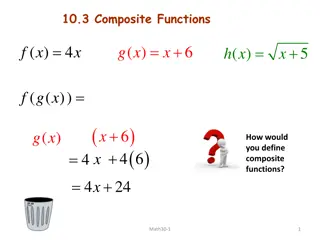Understanding the Rule of Mixtures in Composite Materials
The Rule of Mixtures (ROM) is a weighted method for predicting the properties of composite materials, such as fiber-reinforced polymers (FRP). This method relies on assumptions regarding the homogeneity and properties of fibers and matrices. By combining volume fraction and properties linearly, the tensile performance of composites can be determined. Factors like reinforcement type, orientation, and distribution significantly influence the mechanical properties of composites. The Rule of Mixtures estimates properties like density, modulus of elasticity, shear modulus, Poisson's ratio, and tensile strength. Understanding these principles is essential for designing high-performance composite materials.
- Composite Materials
- Rule of Mixtures
- Fiber-Reinforced Polymers
- Mechanical Properties
- Materials Science
Download Presentation

Please find below an Image/Link to download the presentation.
The content on the website is provided AS IS for your information and personal use only. It may not be sold, licensed, or shared on other websites without obtaining consent from the author. Download presentation by click this link. If you encounter any issues during the download, it is possible that the publisher has removed the file from their server.
E N D
Presentation Transcript
Composite Materials Dr. Abbas Hasan Faris Lecture- 7
Rule of Mixtures The rule of mixtures (ROM) is a weighted method used to predict the properties of composite materials such as a fiber-reinforced polymer (FRP) including the tensile performance based upon the following assumptions: (1) The fiber is homogeneous, linear elastic, and well-arranged regularly in space. (2) The matrix is also homogeneous, linear elastic, and isotropic. (3) There are no voids, the fiber and the matrix are completely coupled. Based on these assumptions, the tensile performance of FRP composed of fiber and polymer in the matrix can be obtained by combining the volume fraction and the tensile properties of the fiber and the matrix linearly.
Mechanical properties of composites depend on the volume fraction of reinforcement and matrix. The basic properties can be calculated using the rule-of-mixture principle with some assumptions The type of reinforcement (fiber, particle or whiskers) and their orientation play a major role in determining the strength of composites In composites, if fibers are oriented at an angle of 0, their strength along the fiber direction will be more than in the other directions In particle-reinforced composites, the distribution of particles throughout the component is key to providing uniform material property
According to the Rule of Mixtures properties of composite materials are estimated as follows: Density Coefficient of Thermal Expansion Modulus of Elasticity Shear modulus Poisson's ratio Tensile strength
Notations used in rule-of-mixture are as follows: c, f, and m represent composite, fiber, and matrix respectively, V is Volume fraction, P is load withstand, A is the cross-sectional area, E is Elastic modulus, is stress, is Strain, is a Poisson ratio and is Density. Volume fraction of fiber, vf = volume of fiber/ volume of composite Volume of composite, Vc= Vf+ Vm For unit volume of composite, 1 = Vf+ Vm Volume fraction of matrix, Vm= 1 Vf The Rule of Mixtures is actually composed of two models: Voigt, W. (1889) and Reuss, A. (1929). The first model is normally applied to calculate elastic modulus in the fiber direction (longitudinal direction), while the second one is used for estimations in the transverse direction.
In general terms Rule of Mixtures may be expressed as follows: ? ?? ?= ? ?? ?? ?? ?+ ? ?? ?? ?? ? ? ?? ?is the composite property ? ?? ?is the fiber property ? ?? ? ?? ?is the volume fraction of fiber ? ?? ?is the matrix property ?is the volume fraction of matrix and = 1- Vf Elastic behavior- Longitudinal loading (continuous and aligned fiber composite) Let the load applied to the composite be Fc. This load is shared by the fiber and the matrix according to the fraction of the cross-sectional area (area perpendicular to the stress direction) occupied by these components.
Hence ??= ??+ ??--------- (1) With ??= ????------------ (?) ??= ????-------- (?) ??= ????------------- (?) Where Ac, Amand Afare the cross-sectional areas of the composite, matrix and fiber (all the fibers together), respectively, such that: ??= ??+ ??------ (?) c, m, fare the stresses of the composite, matrix and fiber, respectively.
Iso-Strain Elastic Modulus of Lamellar Composite Isostrain condition: Equal strain c= f= m= Total applied load Fc= Ff+ Fm Stress = F/A cAc= fAf+ mAm
From equation 1: ????= ????+ ????------- (?) However, ??= ????----------------------(?) ??= ????--------------- (?) ??= ????------------------ (?) Thus, Eq. 6 becomes ??????= ??????+ ??????---------- (??) When a fiber-oriented composite is loaded in the longitudinal direction of fiber the alignment then the strain in the fiber, matrix, and composite are equal (iso-strain). ? ?= elasticity of matrix Due to the isostrain situation (? ?? ?= ? ?? be canceled. Hence, ?= ? ?? ?), the three strains are equal and can
????= ????+ ????----------- (??) Dividing by Ac gives ?? = ?? ?? Where ?? If the composite, matrix, and fiber phase lengths are all equal, the volume fraction of the matrix, (Vm) , and likewise for the fibers, Vf = equation 12 becomes E? ?= ? ?? Or, ? ?? ?= ? ?? Because the composite consists of only matrix and fiber phases; that is, ? ?? It can also be shown, for longitudinal, that the ratio of the load carried by the fibers to that carried by the matrix is ??= ?? + ??(?? ??) ---------(12) are the area fractions of the matrix and fiber phases, respectively. ?? ??and?? ?? ??is equivalent to ?? ??thus ?? ?? ?+ ? ?? ?? ?? ?----------------- (? ?? ?) (Rule of mixture of binary composites) ?(? ? ? ?? ?) + ? ?? ?? ?? ?---- (? ?? ?) ?+ ? ?? ?= ? ?. ?? ???? ????------------------------ (15)
In particle reinforced composite the elastic modulus shall fall between upper and lower values as per volume fraction. Rule of mixture: equation predict that the elastic modulus should fall between an upper and lower bound as shown: Example: Fig. plots upper and lower bound Ec versus Vpcurves for a copper tungsten composite; in which tungsten is the particulate phase. Upper Elastic Modulus of composite, Lower Elastic Modulus of composite,
The longitudinal tensile strength of composite materials is determined mostly by the strength and volume content of the fiber reinforcement. The breaking strength of the fibers is much greater than the strength of the polymer matrix, and therefore the fibers determine the ultimate strength of the composite. The fiber strengths are typically 50 to 100 times higher than the matrix and, consequently, the strength of the matrix has little influence on the in-plane tensile strength of composite materials.
Higher modulus values are obtained with isostrain loading for equal volume of fibers
Example A continuous and aligned glass fiber-reinforced composite consists of 40 vol% of glass fibers having a modulus of elasticity of 69 GPa and 60 vol% of a polyester resin that, when hardened, displays a modulus of 3.4 GPa. (a) Compute the modulus of elasticity of this composite in the longitudinal direction. (b) If the cross-sectional area is 250 mm2and a stress of 50 MPa is applied in this longitudinal direction, compute the magnitude of the load carried by each of the fiber and matrix phases. (c) Determine the strain that is sustained by each phase when the stress in part (b) is applied.
Solution (a) The modulus of elasticity of the composite is calculated using equation (13): E? ?= ? ?? Ec= (3.4 GPa)(0.6) + (69 GPa)(0.4) = 30 GPa (b) To solve this portion of the problem, first find the ratio of fiber load to matrix load, using equation (15); thus, ??= ?.? ??? (?.?) Or Ff= 13.5 Fm In addition, the total force sustained by the composite Fc may be computed from the applied stress and total composite cross-sectional arae Acaccording to: Fc= Ac = (250 mm2)(50 MPa) = 12,500 N However, this total load is just the sum of the loads carried by fiber and matrix phases; that is, Fc= Ff+ Fm= 12,500 N Substitution for Ff from the preceding equation yields 13.5 Fm + Fm = 12,500 N Or Fm = 860 N Whereas Ff= Fc Fm= 12,500 N 860 N = 11,640 N Thus, the fiber phase supports the vast majority of the applied load. ?? ?? ?+ ? ?? ?? ?? ? ?? ????? (?.?)
(c) The stress for both fiber and matrix phases must first be calculated. Then, by using the elastic modulus for each [from part (a)], the strain values may be determined. For stress calculation, phase cross-sectional areas are necessary: Am = Vm Ac = (0.6)(250 mm2) = 150 mm2 and Af = Vf Ac = (0.4)(250 mm2) = 100 mm2 thus, ??= ?? ??? ? ??? ???= ?. ?? ??? ??= ??= = ?? Finally, strains are computed as: ??= ????? ? ??? ???= ???. ? ???
? ? = m ?.?? ??? ?.????? ???= ?. ?? ?? ? Em= ? ? ??= f Ef= ???.? ??? ?????? ???= ?. ?? ?? ? Therefore, strains for both matrix and fiber phases are identical according to isostrain assumption.























